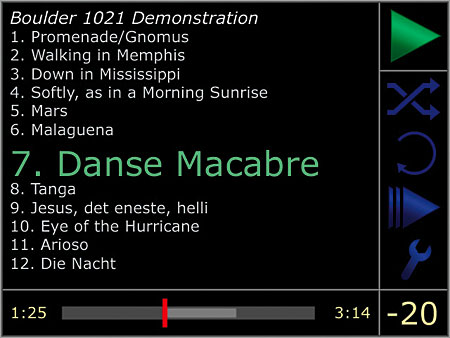| Columns Retired Columns & Blogs |
Boulder 1021 disc player Page 2
The final card, shielded to prevent RF interference, carries an embedded PC running the Linux operating system. (An external display hooked up to the 1021's VGA output will display the boot routine before mirroring the front-panel display.) This PC handles all the display and user-interface chores, and manages the embedded disc database. The final operation at the factory before packing up a 1021 for shipping is to load its non-volatile memory with the most recent version of the database. (Other than noting that it doesn't appear to be the Gracenote/CDDB database, I'm not sure which the 1021 is shipped with.) The player's data storage is four times larger than required, allowing for a long lifetime of metadata updating.
Interlude
My auditioning of the Boulder 1021 was divided into two periods: before and after I used as my main player the Meridian 808i.2, reviewed in April. Before the Meridian, the 1021 sample I had would play CDs and data CD-Rs carrying hi-rez files, but toward the end of the time I was using the Meridian, Boulder sent me a CD-R containing a firmware upgrade for the 1021 that would allow it to play data DVDs, such as Reference Recordings' HRx discs. Installing the new operating system (v.6641) required opening up the Boulder in order to plug a standard PC keyboard into a port on the embedded PC card, but the instructions were meticulously clear: I had the updated player working again within 20 minutes.

Sound
Listening first to CDs, I found myself more impressed by the metadata display than I had anticipated, not least because it's large enough to be legible from my listening chair. The first disc I played was a Stereophile CD, Attention Screen's Live at Merkin Hall (STPH018-2), and yes, there was the track and album info. I found myself reaching for increasingly obscure discs to see if I could catch out the 1021, but the database was comprehensive. Even a 1985 Chandos CD of English string music from George Hurst conducting the Bournemouth Sinfonietta (CHAN 8375) was recognized.
Once I started my formal auditioning, first up was a CD I hadn't listened to for a while, the Jerome Harris Quintet's Rendezvous (Stereophile STPH013-2), which I recorded in Chad Kassem's Blue Heaven Studios a decade ago. My first close-miked, multitrack digital recording to be commercially released, it features an unusual lineup of alto sax, trombone, vibes, acoustic bass guitar, and drums. I remember the mix as being difficult: balancing the loud winds and drums against the somewhat reticent vibes and bass guitar without diminishing the sense of the church acoustic. Some have felt that the bass guitar is too quiet; yet, as reproduced by the Boulder, Jerome Harris's inventive playing provided a well-defined foundation for the ensemble. Had the bass been louder, such passages as the delicate opening of "Only Them," where the bass underpins Steve Nelson's contemplative vibe figuring against Billy Drummond's caressed cymbals and brushed snare, would have lost their delicacy.
In fact, it was the Boulder's combination of low-frequency weight and upper-bass definition that continued to impress me throughout my auditioning. On both Rendezvous and Live at Merkin Hall, the very different-sounding kick drums punched through the mix without boom or softness—as did the, again, very different sounds of the bass guitars.
A riff Chris Jones briefly played on his fretless Fender on Merkin Hall reminded me of the 2005 remastering of Andreas Vollenweider's Behind the Gardens—Behind the Wall—Under the Tree (CD, Kinkou Music KIN 17543), which had been recommended to me by a reader following my mention of the original mid-1980s CD (CBS MK 37793) in my March 2009 review of the Simaudio Moon Evolution P-7 preamplifier. (The Boulder's screen correctly displayed the metadata for both versions of this recording.) The older CD had analog tape hiss that was a little too audible when the CD was played at satisfyingly loud levels, and there was a slight coarseness of textures that I had assumed could be laid at the feet of the early digital recorder used to master the CD. The remastered CD is definitely cleaner, but it is also significantly louder; ie, it has a higher average level for the same peak level, and lacks some of the delicate sense of space that had attracted me to the recording when it was first released on vinyl in the early 1980s. With its grain-free highs, the Boulder allowed me to easily discern these differences without obscuring them with its own signature.
It was with high-resolution recordings that the Boulder 1021 really came into it own. In February, for one of my 2009 "Records To Die For," I picked the Dunedin Consort's powerful one-to-a-part performance of J.S. Bach's St. Matthew Passion (SACD, Linn CKD 313), which I had auditioned as 24-bit/88.2kHz FLAC files downloaded from the Linn Records website. I burned the files to a data DVD-R and inserted it in the Boulder's transport. "Checking Files," reported the player's display as the filenames flashed by at the top. Once it had done that, the playlist appeared in the main window, with the ensemble and the name of the album at the top, and each track identified by filename. I highlighted track 1 and pressed Play. "24 bit/88.2kHz" briefly appeared at the bottom of the display, to be replaced by the usual thermometer display. The light-gray symbol for the read-ahead buffer moved noticeably less far ahead of the red timeline indicator than it had done with CD, due to the need to pull four times as much audio data from the disc for each moment of music.
- Log in or register to post comments



































